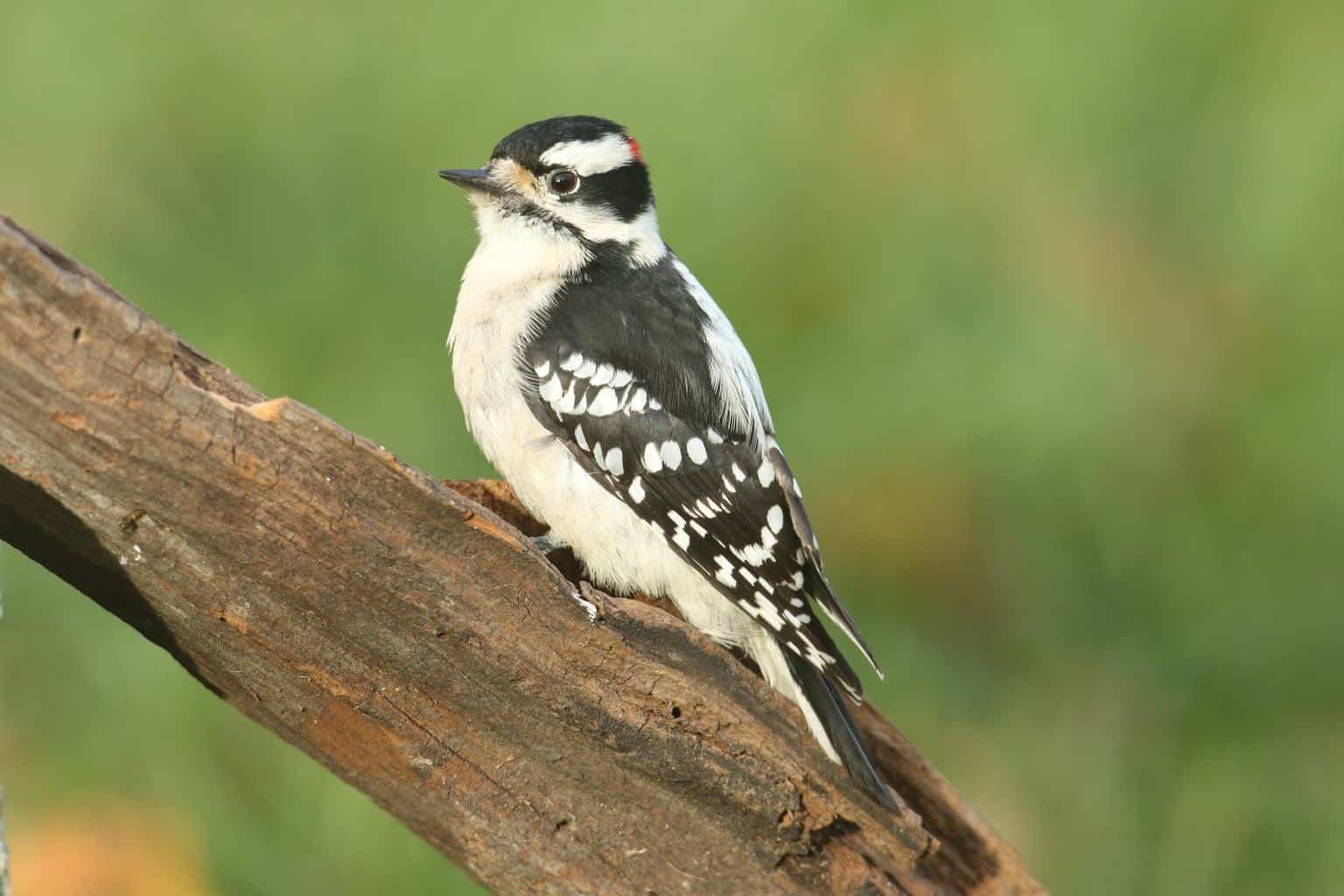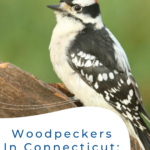A perfect getaway from the busy life of most major cities, Connecticut offers an exciting blend of New England scenery, Ivy League campus experience, living history, and mouth-watering cuisine.
In addition to all these activities that you can enjoy, Connecticut is also famous for its amazingly diverse wildlife, particularly when it comes to birds. This state is home to a total of 445 bird species, with 293 of them known to be regular visitors or year-round residents.
7 species of woodpeckers live throughout Connecticut’s forests, woodlands, orchards, residential areas, and city parks. Below is a list of the most common woodpeckers you can find in Connecticut.
1. Red-Headed Woodpecker

- Scientific Name: Melanerpes erythrocephalus
- Length:3 – 9.9 inches
- Weight:0 – 3.4 oz
- Wingspan:9 – 14.6 inches
- Additional Information: sporting a bright red set of head feathers, this bird is quite easy to spot from a distance. Identifying these woodpeckers, however, can be a bit tricky since young Red-Headed Woodpeckers actually display brown heads until they’re about 1 year old.
As a result, you may very well confuse them with other species. Luckily, they develop their vibrant colors as they age. These birds are rather widespread across Connecticut, where you can see them nesting in deadwood trees, parks, and clearings near forests.
2. Red-Bellied Woodpecker

- Scientific Name: Melanerpes carolinus
- Length:0 – 10.5 inches
- Weight:0 – 3.2 oz
- Wingspan:0 – 16.5 inches
- Additional Information: showing off a dazzling red cap from their forehead to the base of their neck (females have red only on their necks) and a distinctive black & white zebra pattern on their back, you can easily pinpoint the red-bellied woodpecker from other birds.
Despite their name, these birds actually display a small patch of pink on their underside that can be somewhat difficult to see yet still a distinctive characteristic. You can find the Red-Bellied Woodpecker all year-round in Connecticut. Though these birds don’t migrate, they might head down to lower elevations or even south if the weather demands.
You can mostly see the Red-bellied woodpecker on the eastern side of the state in forests with plenty of old trees.
3. Downy Woodpecker

.Scientific Name: Dryobates pubescens
- Length:5 – 6.7 inches
- Weight:7 – 1.0 oz
- Wingspan:8 – 11.8 inches
- Additional Information: small and adorable, the Downy Woodpecker is known to nest in deadwood trees at tall heights that can be alarming at times. Spotting the Downy Woodpecker is a year-round possibility in Connecticut as long as you know where to look. Woodlots, residential areas, and city parks are your best bet.
Make sure that you listen for the characteristic high-pitched pik note and the descending whinny call. While flying, look for a small black & white bird (males have a small red patch on the back of the head) with a wavy flight path
4. Hairy Woodpecker

- Scientific Name: Dryobates villosus
- Length:1 – 10.2 inches
- Weight:4 – 3.4 oz
- Wingspan:0 – 16.1 inches
- Additional Information: This black & white beauty is a distant cousin of the Downy Woodpecker. In fact, many considered it just a larger version of two look-alikes.
The Hairy Woodpecker does share a lot of similarities with the Downy Woodpecker, including territory, but it sticks to foraging large trunks and main branches of trees as opposed to smaller branches.
The Hairy Woodpecker has a signature call, which is a sharp series of notes, that makes its presence pretty easy to figure out. You can find this woodpecker any time throughout the year in Connecticut, spending its time hunting around for insects.
5. Yellow-Bellied Sapsucker

- Scientific Name: Sphyrapicus varius
- Length:1 – 8.7 inches
- Weight:5 – 1.9 oz
- Wingspan:4 – 15.8 inches
- Additional Information: these medium-sized woodpeckers sport black wings with white marks on their back. The Yellow-bellied Sapsucker also has a longitudinal wing stripe and a cream-colored underside with streaks.
Both sexes have a black bib and red foreheads. Male sapsuckers have a red throat as well, while females have a white throat. Young Yellow-bellied sapsuckers are a mottled brown color and lack the red crown, red throat, or black bib.
This woodpecker prefers to live in forests, woodlots, and orchards, where it feeds on tree sap, insects, fruits, berries, and tree buds. It drills in more than 200 native tree species, but it enjoys white birch the most since it offers the highest sap sugar content.
6. Northern Flicker

- Scientific Name: Colaptes auratus
- Length:0 – 12.2 inches
- Weight:9 – 5.6 oz
- Wingspan:5 – 20.1 inches
- Additional Information: Flickers are categorized into two distinct groups, both of which have brown backs and wings with black barring. They feature a tan face and a buff to greyish belly with heavy black spotting.
You can identify the Yellow-shafted Flicker, found in the eastern United States which includes Connecticut, by its yellow underwings and undertail, a red nape crescent with a grey crown, a grey or tan forehead, and a black mustache. The female yellow-shafted flicker doesn’t have the black mustache
The Red-shafted Flicker, residing in the western United States, sports reddish underwings and undertail with a red mustache.
Generally speaking, the Northern Flicker prefers to live in the open country close to large trees, forest edges, parks, and residential areas. These birds eat insects, especially ants and beetles. They also eat seeds and fruits.
7. Black-Backed Woodpecker

- Scientific Name: Picoides arcticus
- Length:1 inches
- Weight:1 – 3.1 oz
- Wingspan:8 – 16.5 inches
- Additional Information: these woodpeckers are Inky black above and white below. Males have a yellow crown patch that’s absent in females. The Black-backed woodpeckers live in coniferous forests of northern North America and the western mountains, but it can be rarely spotted in Connecticut.
They prefer fir, pine, spruce, hemlock, tamarack or larch, white-cedar, and sometimes aspen. However, they reach their highest densities in recently burned areas.
8. Pileated Woodpecker

- Scientific Name: Dryocopus pileatus
- Length:8 – 19.3 inches
- Weight:8 – 12.3 oz
- Wingspan:0 – 29.5 inches
- Additional Information: native to North America, the Pileated Woodpeckers are large and mostly black. They have white stripes on the face and neck, along with a bright red crest.
These woodpeckers mainly feed on insects. They require big, standing dead trees and downed wood for habitat. In the East, they live in all types of forests and may even be spotted in partially wooded suburbs and backyards.
Wrap Up
With so many stunning woodpeckers to see in Connecticut, it’s easy to see why it can be a fine destination for any bird watching enthusiast.





















